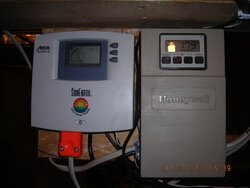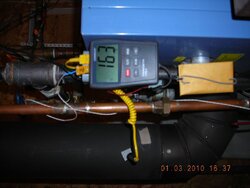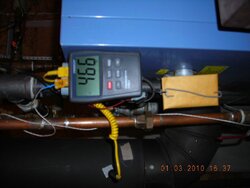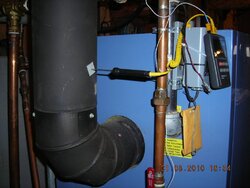...the name on the the meter...
I'll respond later with the actual name, but I wouldn't be too concerned with the name. If you search "digital thermometer" on ebay, you will come up with lots of listings, single and dual input, as well as other kinds, and most look pretty much the same and pretty much the same price. Find one you like and I doubt you can wrong in choosing one over the other.
Dave:
Jim, is that Honeywell controller a two stage that kicks your second boiler circulator on at high boiler temps (as you described in recent weeks)?
Yes, it is the Honeywell, and good memory on your part. My current settings (sensor on the supply pipe about 1 foot after it leaves the boiler, cable tied and wrapped with insulation): Honeywell Stage 1 "on" at 145F and off at 140F. Stage 1 turns "on" the differential controller (DC) which controls C1. C1 "on" when supply temp is +10F over bottom of tank, and "off" at +8F. Honeywell Stage 2 "on" at 188F and "off" at 185F. Stage 2 controls C2 to give the high temperature flow boost which virtually eliminates idling. In round numbers, C1 provides 2-5 gpm based on temperature and Termovar feed back, and C1+C2 provides about 8 gpm.
And how are you using that differential controller? Forgive me if you’ve recently described it.
The benefit of the DC is with high temperature storage loading, provided maximum bottom of tank temp is less than 185F. As bottom of tank approaches within 8F of supply temp, C1 is "off," but so long as supply temp remains higher than 185F C2 remains "on." This takes care of most end of burn cycles as the last heat is transferred to storage. When supply temp falls below 185 F, C2 then is "off."
One small fly in the ointment is when I charge the entire tank to about 185F and 185F+ water is circulating between the tank and the boiler, because then DC likely will turn "off" C1, as approach temp is < 8F, and C2 will remain "on" even when there is no fire left. I've dealt with this in 2 ways. The first way: the Tarm has a cool-down shutoff with a sensor in the smoke box, which I have set at 100C. When the smoke box cools to 100C, the Tarm shuts down. I have wired a relay in this control circuit to also shut down the entire system when the Tarm shuts down. This works, but it does leave C2 running for quite awhile after the fire dies down in high storage temp situations, like tank charged to 190F. With 190F water continuing to circulate, it takes a long time for the smoke box to cool to 100C.
The second way: If I plan on charging the tank to bottom of tank > 185F, then I put a timer on the system electrical circuit that shuts everything down. I will load the quantity of wood that is likely to provide the full 190F+ tank charging and be burned out, and then set the timer for 4 hours, giving plenty of time to make sure that the wood is burned out. This wood load quantity is a bit critical, because if too much wood and tank at 193F (the maximum I can reach), the boiler is still providing heat with no place to go and ... overheat occurs.
To deal with overheat, I've put an aquastat on the boiler supply line which cuts power to the Automag at 200F, allowing the overheat loop to absorb excess boiler heat. And at 210F the Tarm overheat aquastat also shuts down the entire system. At least I know my overheat loop works as intended, as it has kicked in a couple of times and I've never experienced excessive boiler pressure to trigger the pressure relief valve. Everyone should give their overheat system a test on power failure, wood load still in boiler, to make sure it functions as intended.
Dave, a long answer to your simple questions. Have a very good day and Happy New Year.





